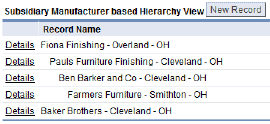Self Reference Lookup
From AgileApps Support Wiki
Revision as of 19:16, 6 May 2011 by imported>Aeric
An Object can contain a Lookup field that references the Object itself (i.e. a self reference). This configuration is used to build record hierarchies (parent-child relationships between records) which are displayed in a Related Information section.
- Examples
- An organization might have multiple subsidiaries, and some of those companies might also have subsidiary companies
- Employees have reporting relationships, to managers and subordinates
- In manufacturing, parts in a component might have subcomponents (or be part of of a larger component)
- Considerations
- When a Self Reference Lookup field is added, a new section is added to Related Information
- The new section is named: <object> based Hierarchy View, where <object> is the Lookup Type, or object name; Learn more: About Objects in Lookup Fields
- The new section is added to all the Form Layouts of the object
- By default, this new section is hidden
- When visible, this section displays a hierarchy view of the records
- A Self Reference Lookup field:
- Cannot reference itself, only other records in the object
- Is not supported in System Objects
- Is not supported in lookups to System Objects
- Is not supported in Object Inheritance models
- Can be deleted from the Fields tab in an Object
Add a Self Reference Lookup Field to an Object
- Click Designer > Data & Presentation > Objects > {object}
- Click the Fields tab, click the [New Field] button, and complete the following information:
- Label
- Label to display in the form layout
- Display Type
- Lookup
- Object Name
- Choose the {object} selected in the first step
- Field Name
- Name of the field (Parent {object} is a common choice)
- Section
- Choose a section in the form layout (default selection can be used)
- Complete any other optional fields and click the [Save] button to save your changes
- Click the Form Layouts tab and scroll to the Related Information Section
- Click the Display Settings link in the Related Information Section heading bar
- Move the object labeled: {object} based Hierarchy View to the Visible Objects area
- Click [Save]
Create a Self Reference Lookup between Records
- Navigate to the {object} tab (Company, for example)
- Edit a record, select a Parent Company from the lookup field and Save the record
- Select the record designated as Parent Company
- Scroll down to the Company based Hierarchy View section
- Note that child Companies are displayed in the tree, demonstrating the relationships between records in the Company object
Edit an Object based Hierarchy View
To edit an <object> based Hierarchy View:
- Click Designer > Data & Presentation > Objects
- Navigate to the object of interest
- In the Form Layouts tab, navigate to the Related Information section
- Navigate to the <object> based Hierarchy View, click the Edit Related Information
 icon and complete the following information:
icon and complete the following information:
-
- Title
- Title of the Related Information section
- Prepopulated with <object> based Hierarchy View
- Optionally, change the Title
- Select Fields to Display
- Select fields in the list of those Available, and click the right-arrow button to move them to the Selected column; Optionally, click the up- or down-arrow buttons to change the order in which the fields appear
- Sort By
- Choose a field to determine the sort order of the records, and choose either Descending or Ascending order
- Additional Sort By
- Optionally, choose a second-level sort
- Choose a field to determine the sort order of the records, and choose either Descending or Ascending order
- Display Type
- Choose from Tree or Tabular; Tree is default
-
- If Display Type is Tree, the Mode Type option is displayed
- Choose either Collapsed or Expanded; Collapsed is default
- Scrolling Window Size
- Define the number of rows to display by selecting a Scrolling Window Size; Choose from:
- No Scrolling, Show all Rows
- 5 Records, Scroll Window
- 10 Records, Scroll Window
- 20 Records, Scroll Window
- 30 Records, Scroll Window
- 40 Records, Scroll Window
- 50 Records, Scroll Window
- Click [Save]
The <object> based Hierarchy View records are displayed in the Related Information section.
Delete an Object based Hierarchy View
To Delete an Object based Hierarchy View, delete the field that is associated with this Related Information Section.
- Click the field name.
- Click [Delete].
A confirmation dialog opens. - Click [OK] to delete the field.
This is a permanent deletion, and cannot be restored.

